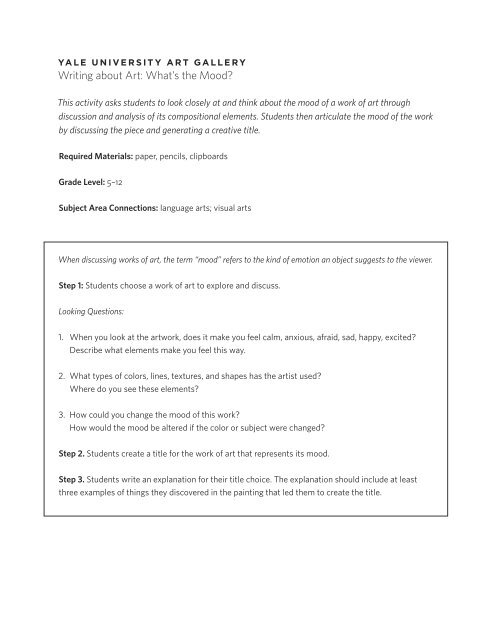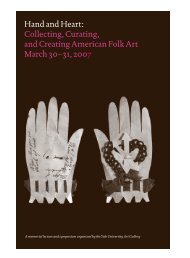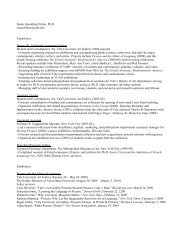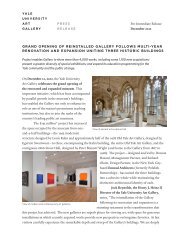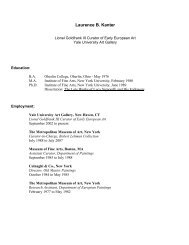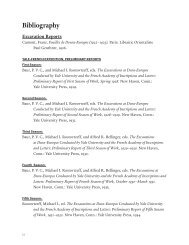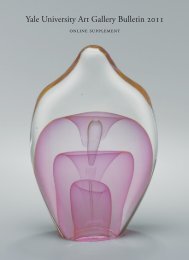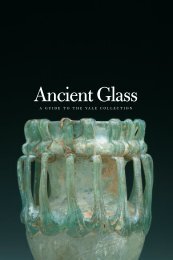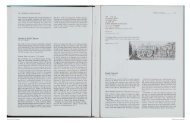Writing about Art: What's the Mood? - Yale University Art Gallery
Writing about Art: What's the Mood? - Yale University Art Gallery
Writing about Art: What's the Mood? - Yale University Art Gallery
Create successful ePaper yourself
Turn your PDF publications into a flip-book with our unique Google optimized e-Paper software.
YA L E U N I V E R S I T Y A R T G A L L E R Y<br />
<strong>Writing</strong> <strong>about</strong> <strong>Art</strong>: What’s <strong>the</strong> <strong>Mood</strong>?<br />
This activity asks students to look closely at and think <strong>about</strong> <strong>the</strong> mood of a work of art through<br />
discussion and analysis of its compositional elements. Students <strong>the</strong>n articulate <strong>the</strong> mood of <strong>the</strong> work<br />
by discussing <strong>the</strong> piece and generating a creative title.<br />
Required Materials: paper, pencils, clipboards<br />
Grade Level: 5–12<br />
Subject Area Connections: language arts; visual arts<br />
When discussing works of art, <strong>the</strong> term “mood” refers to <strong>the</strong> kind of emotion an object suggests to <strong>the</strong> viewer.<br />
Step 1: Students choose a work of art to explore and discuss.<br />
Looking Questions:<br />
1. When you look at <strong>the</strong> artwork, does it make you feel calm, anxious, afraid, sad, happy, excited?<br />
Describe what elements make you feel this way.<br />
2. What types of colors, lines, textures, and shapes has <strong>the</strong> artist used?<br />
Where do you see <strong>the</strong>se elements?<br />
3. How could you change <strong>the</strong> mood of this work?<br />
How would <strong>the</strong> mood be altered if <strong>the</strong> color or subject were changed?<br />
Step 2. Students create a title for <strong>the</strong> work of art that represents its mood.<br />
Step 3. Students write an explanation for <strong>the</strong>ir title choice. The explanation should include at least<br />
three examples of things <strong>the</strong>y discovered in <strong>the</strong> painting that led <strong>the</strong>m to create <strong>the</strong> title.
Frans Hals (Dutch, 1581/85–1666)<br />
De Heer Bodolphe, 1643<br />
Oil on canvas, 48 3/16 x 38 3/8 in. (122.4 x 97.5 cm)<br />
Bequest of Stephen Carlton Clark, b.a. 1903<br />
1961.18.23
Vincent van Gogh (Dutch, 1853–1890)<br />
The Night Café, 1888<br />
Oil on canvas, 28 1/2 x 36 1/4 in. (72.4 x 92.1 cm )<br />
<strong>Yale</strong> <strong>University</strong> <strong>Art</strong> <strong>Gallery</strong>, Bequest of Stephen Carlton Clark, b.a. 1903<br />
1961.18.34
Kazimir Severonic Malevich (Russian, 1878–1935)<br />
The Knife Grinder (Principle of Glittering), 1912–13<br />
Oil on canvas, 31 5/16 x 31 5/16 in. (79.5 x 79.5 cm)<br />
Gift of Collection Société Anonyme<br />
1941.553


